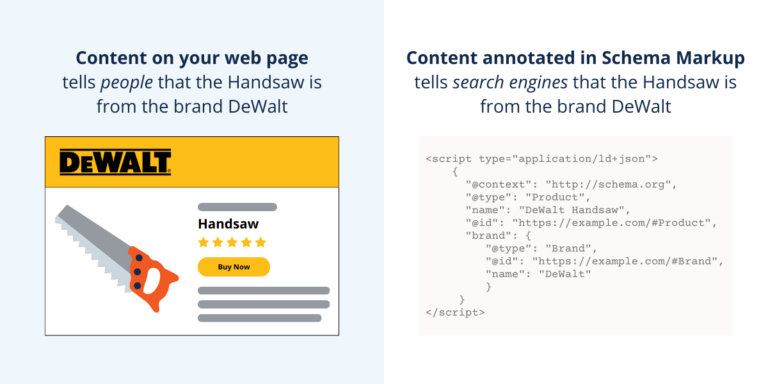What Is Schema Markup?
Schema Markup, also known as Structured Data, is data that you can add to your web page’s HTML code to explicitly define entities, properties, and relationships within your content. By doing so, it assists search engines in better comprehending and contextualizing your page content, thereby enabling them to deliver more accurate search results to users.
In the digital marketplace, incorporating robust Schema Markup is one of the most critical steps you can take to get noticed. Schema Markup enables search engines to understand your web page content, effectively rank it, and present users with relevant (and even visually enhanced) search results.
Schema Markup is created using the Schema.org vocabulary, a collaborative project involving major search engines like Google, Bing, Yahoo, and Yandex. The primary objective of Schema.org is to establish a standardized vocabulary for describing content on web pages, making it simpler for search engines to understand and interpret the meaning of various elements present on a webpage.
Although search engines use sophisticated machine learning algorithms, machines do not process or interpret information in the same way as humans. What might seem simple to a person may be unintelligible to a computer. Schema Markup helps fill in the blanks for search engines so that they know exactly what your page is about.
For instance, let’s say you have a product detail page containing an image and description of a handsaw, along with an image of the brand in the header.

A person reading this would immediately realize that the handsaw is from the brand “Dewalt,” but it might be difficult for search engines to understand that explicitly. You can use Schema Markup to identify that the brand of handsaw on this page is “Dewalt” so that the search engine can present this content for individuals searching phrases like “Dewalt handsaw.”
Sign up for our Schema Markup 101 Training Course
Learn the basics of Schema Markup and how to build a robust Schema Markup strategy
What are the main SEO benefits of using Schema Markup?
1. Help search engines understand the content on your page
Schema Markup enriches your website content by organizing its data in a way that is easily and accurately interpreted by search engines.
This gives search engines a more semantic understanding of what entities and topics your page covers, leading to more relevant search results. It also grants you more precise control over how search engines understand your content.
As such, search engines can intelligently display your content to the appropriate users. This targeted visibility can lead to higher clicks, impressions, and click-through rates, ultimately driving better-quality traffic to your site.
To delve deeper into how Schema Markup impacts your SEO efforts, refer to our ‘Common Questions About Schema Markup for SEO’ blog article.
2. Develop a Content Knowledge Graph that supports Generative AI Search
Structured data provides the foundation for developing your organization’s content knowledge graph.
Schema Markup not only describes the entities on your site but also outlines their relationships to other entities on your site and across the web. By implementing robust connected Schema Markup, you are building a content knowledge graph—a reusable data layer that captures relationships between various entities on your site using a standardized vocabulary like Schema.org.
This structured data framework is crucial for training and grounding generative AI search engines and other LLMs, which rely on factual data to mitigate errors and hallucinations.
Gartner has also identified knowledge graphs as a critical enabler for generative AI adoption, further highlighting Schema Markup’s fundamental role in AI advancements.
3. Achieve Rich Results
Implementing certain types of structured data can also enable search engines to display visually enhanced search results (aka rich results) instead of generic “plain blue link” results listings.
Rich results enhance standard search results by presenting additional information, such as a business location, images, product reviews, etc. Rich results are also referred to as enriched results or rich snippets, as they provide snippets of information about a page, brand, or business.
Example of a Product Rich Result

Example of a Review Snippet

Rich results are visually appealing and informative, making your listings stand out on the SERP and improving the overall search experience for users. By incorporating structured data, you cater to both customer needs and search engine algorithms, increasing your competitiveness in search results.
What Types of Schema Markup are there?
There are many different types of Schema Markup that you can incorporate into your online content. Some of the most commonly used markup types include:
- Reviews: This type is used to mark up reviews for products, services, or other items. It includes properties like the reviewer’s name, rating, and review text.
- Product: Product markup is used for e-commerce sites to describe specific products. It includes details such as name, description, price, availability, and more.
- Local Business: This markup type is ideal for businesses with physical locations. It includes properties like name, address, phone number, opening hours, and geographical coordinates.
- Person: Person markup is used to describe individuals, including properties such as name, job title, contact details, and social media profiles.
- Organization: Similar to local business markup but broader, organization markup can be used for any type of organization, including corporations, educational institutions, non-profits, etc. It includes details like name, logo, contact information, and social profiles.
- Event: Event markup is used for marking up events such as concerts, workshops, or conferences. It includes properties like event name, date, location, and ticket information.
- Media Objects (images, videos, audio): Markup for media objects like images, videos, or audio files. It can include properties such as caption, thumbnail URL, and duration.
- Creative Works (movies, books, music, TV series, recipes): This type covers a range of creative content, including movies, books, music, TV series, and recipes. It includes properties specific to each type, such as author, director, actors, duration, and ingredients for recipes.
Choosing the right schema type depends on the nature of your content. Each type comes with its own set of properties that you can use to provide detailed and structured information about the content on your webpage. You can view the full list of Types here and learn more about the Schema.org vocabulary here.
What is the recommended format for implementing Schema Markup?
The most commonly used formats for implementing structured data are JSON-LD, microdata, and RDFa. However, Google recommends using JSON-LD due to its readability for both humans and machines.
Implementing JSON-LD (JavaScript Object Notation for Linked Data) is easier than implementing other formats like microdata or RDFa, and you can seamlessly incorporate it within the HTML of your web pages. This format is favored for its simplicity and effectiveness in conveying structured data to search engines.
How to implement Schema Markup on your site
Manually generate your own code and paste it on your site
One way to implement Schema Markup is to do it manually using the following steps.
- Review Page Content: Examine each page on your site and identify what the page is mainly about.
- Choose Schema Types: Select the appropriate schema type and properties that best describe the content on your page.
- Write the JSON-LD: Create the Schema Markup in JSON-LD using the chosen schema types and properties.
- Embed JSON-LD in HTML: Incorporate the Schema Markup JSON-LD into the HTML of your webpage.
- Test Markup: Use tools like Google’s Rich Results Testing Tool (if you aim to achieve a rich result) or Schema.org’s Schema Markup Validator to validate and ensure correct implementation and desired results.
If you have the technological savvy to write the JSON-LD and can meticulously work through each page of your site’s content, this approach is a viable option.
However, the manual method of implementing Schema Markup is incredibly labor-intensive—especially if you have a huge website. Similarly, bringing in your own IT team to write and deploy the code can also be costly and time-consuming.
Use a Schema Markup Plugin
Instead of implementing the markup manually, you can opt to use a Schema Markup plugin to implement Schema Markup programmatically.
There are many Schema Markup plugins available for WordPress, Shopify and other CMSes that will allow you to add markup to your page programmatically. However, many Schema Markup plugins tend to be limiting in terms of the Schema type and properties you can leverage. You will also have little control over marking up each page.
Learn more about the pros and cons of using a Schema Markup plugin here.
Hire a Schema Markup Expert
The best way to implement advanced custom Schema Markup would be to hire a Schema Markup solutions provider like Schema App. At Schema App, we provide an end-to-end Schema Markup Solution through our leading semantic technology platform and a team of experts.
Our platform includes tools like our Highlighter and Editor that allow users to generate, deploy, and manage their structured data at scale. Our team of Schema Markup experts will also help you manage your structured data from strategy to results, deploying Markup at scale without diverting your in-house IT resources.
You can focus on your core marketing activities and trust us to deal with the complexities and nuances of your structured data.
Navigate the Complexities of Schema Markup with Schema App
Whether you choose to implement Schema Markup independently or require a solution like Schema App to expertly manage your organization’s Schema Markup, leveraging structured data offers a myriad of advantages for your SEO, AI, and semantic strategies.
If you need help implementing a robust Schema Markup strategy for your site, get in touch with us today.

